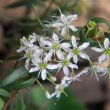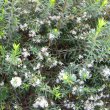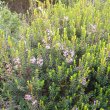| Botanical Name |
Agathosma ovata - Kluitjieskraal |
| Family |
Rutaceae - The rue, buchu & citrus family. |
| Pronunciation |
ag-ath-OHS-muh oh-VAY-tuh |
| Common Name(s) |
Afrikaans: Basterboegoe; Bosboegoe; Rivierboegoe; Wildeboegoe
|
| Plant Group |
- Fynbos Certain plants endemic to the areas of the Western Cape of South Africa that have a Mediterranean climate of cold, wet winters and hot, dry summers.
- Shrub A woody plant of relatively low height, having several stems arising from the base and lacking a single trunk; a bush.
|
| Plant Size |
- Small
| Tree | 4m to 8m |
| Shrub | 50cm to 75cm |
| Perennial/ground cover | 10cm to 20cm |
| Bulb | 20cm to 30cm |
| Succulent | 10cm to 20cm |
|
| Position |
- Partial Shade The area is in shade for part of the day and in full sun for part of the day.
- Sun The area is in full sun for all or most of the day, all year round.
|
| General Information |
- Drought Tolerance: High The plant is well adapted to arid conditions; it can survive long periods of drought and high temperatures without extra water.
- Evergreen Plants that have leaves all year round.
- Fragrant / Aromatic These plants posses a strong, usually pleasant odour.
- Roots Non-invasive Safe to plant near pools, paving, walls or buildings.
- Sand tolerant Plants adapted to survive in nutrient poor, very sandy soils.
- Water Wise Plant species originating from low rainfall regions that require less water to survive and thrive than other plant species.
- Wind Tolerant Plants able to withstand the effect of strong winds.
|
| Specific Information |
Agathosma ovata forms a compact, evergreen shrub with small leaves and flowers that cover the bush in an eye-catching display. The volatile oils in the leaves protect the bushes from pests, making them useful for the herb or vegetable garden.
|
| Ad Break |
|
| Flowers |
| Description |
tiny, star-shaped, 5 petals, in round heads 8 mm across
|
| Season |
- Autumn to Spring Plants will seldom bloom for the entire season as given in the list, but should flower during a period within these parameters.
|
| Colour |
|
| Growth Rate |
- Moderate Specifying growth rate can be very misleading as there is considerable variation of growth rate depending on type and species of plant, available water, supplementary feeding, mulching and general care, as well as the plants suitability and adaptability to the garden environment.
|
| Plant Uses |
- Attracts bees, butterflies or other insects This plant attracts insects which can be food for birds or other creatures in your garden.
- Border A strip of ground, at the edge of a driveway or path in which ornamental plants or shrubs are planted.
- Container Trees, shrubs and ornamental species that can adapt to growing in a restricted environment.
- Edging A low growing plant that provides softness or definition to the edges of a bed or walkway.
- Filler Either a fast growing tree or shrub used temporarily to fill in an area while the permanent plants grow to a desired size, or a plant used to fill gaps in borders or beds.
- Ground Cover Low-lying plants that spread fast, require minimal maintenance, and cover large expanses or bare areas between bulbs or shrubs. They provide protection from erosion and drought and improve the visual appearance of the garden.
- Hedge Suitable trees or shrubs planted relatively close together so that the branches intertwine to create a barrier. This can be formal – the plants are regularly trimmed to produce a neat shape, or informal – the plants are left to themselves to create a natural hedgerow.
- Rock Garden An area constructed of larger rocks, arranged naturally, to emphasise the use of stones as a main element. Generally plants used do not need a lot of care.
- Suitable for coastal gardens Plants adapted to dry, sandy soil, forceful wind, limited rainfall and intense sunlight.
- Suitable for seaside gardens Plants that will survive the hostile environment of harsh salty winds, dry sandy soil, irregular rainfall and heat found in seaside gardens.
- Suitable for smaller gardens Such plants do not have invasive root systems, remain small or controllable and can often be grown in containers.
- Wild Garden An indigenous garden planted for the benefit of wildlife and birds. Provides food, water, a variety of mini-biomes and no poisonous chemicals are used.
|
| Distribution and Habitat |
Western Cape, Eastern Cape and Kwazulu-Natal, as well as Lesotho, in sandstone or gravelly soil
|
| Planting Suggestions |
This buchu adapts easily in any garden and requires a well-drained, humus rich soil. It should not receive shade for more than half the day. Agathosma ovata requires moderate watering until established and will respond well to a slow release fertilizer such as 3:1:5. Add iron chelate if the leaves are yellow. Pinch back new tips to encourage bushy growth.
|
| Medicinal Uses |
|
| Ad Break |
|









Discuss this plant
Share knowledge, ask a question or give an experience.